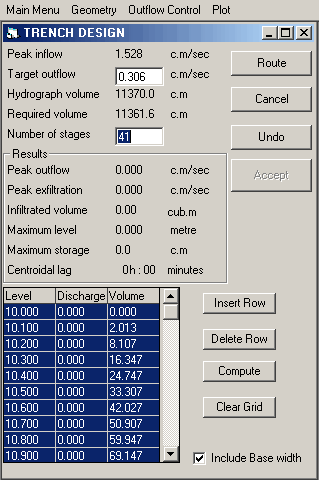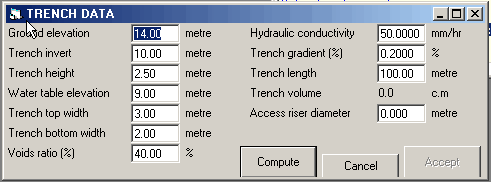|
|
|
Design Exfiltration Trench |
|
|
The Trench command lets you proportion an exfiltration trench to provide underground storage for flow peak attenuation and also to promote return of runoff to the groundwater. The trench usually consists of a trench of roughly trapezoidal
cross-section filled with clear stone with a voids ratio of around
40% and with one or more perforated pipes to distribute the inflow
along the length of the trench. The outflow control devices are similar to those used in the detention Pond command. Water from the inflow hydrograph enters the stone fill through one or more perforated pipes running the length of the trench. The trench may also have a conventional, un-perforated storm sewer between the manholes to convey the Outflow. The positioning of the various pipes in the trench can be defined graphically using the Trench pipes window. The diameter and type (perforated or non-perforated) can be specified and the location set by dragging the pipe to the desired position or by editing the numerical data in a grid. During the drag and drop procedure the current pipe cover is shown to assist in ensuring adequate clearance.
[Please click
|
|
|
|
|
|
(c) Copyright 1984-2023 Alan A. Smith Inc. |
|
|
|

 The exfiltration trench splits the inflow hydrograph into two
components. One of these is the flow which infiltrates into the
ground water; the balance of the inflow is transmitted as an
outflow hydrograph. Obviously an exfiltration trench requires
reasonable porosity of the soil and a water table below the trench
invert.
The exfiltration trench splits the inflow hydrograph into two
components. One of these is the flow which infiltrates into the
ground water; the balance of the inflow is transmitted as an
outflow hydrograph. Obviously an exfiltration trench requires
reasonable porosity of the soil and a water table below the trench
invert.
